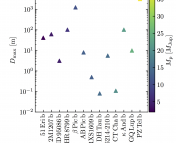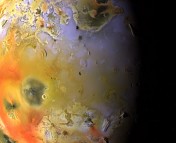Title: A Circumplanetary Disk around PDS70c
Authors: Myriam Benisty, Jaehan Bae, Stefano Facchini, Miriam Keppler, Richard Teague, Andrea Isella, Nicolas T. Kurtovic, Laura M. Perez, Anibal Sierra, Sean M. Andrews, John Carpenter, Ian Czekala, Carsten Dominik, Thomas Henning, Francois Menard, Paola Pinilla, Alice Zurlo
First Author’s Institution: Univ. Grenoble Alpes, CNRS, IPAG, 38000 Grenoble, France
Status: Published in The Astrophysical Journal Letters [open access]
How do moons form in the universe? We know moons are fairly common in our own solar system. Aside from the Earth’s dancing partner, there are over 200 moons surrounding planets orbiting the Sun. It seems reasonable then, that planets orbiting other stars (called “exoplanets”) also host moons. The hunt for evidence of fully formed exomoons via the transit method (catching the dimming of a star as a planet passes between it and our line of sight) has been plagued by false positives. The recent high-profile discovery of the promising exomoon candidate, Kepler-1708 b-i, might still have the public wondering, “how do exomoons form in the first place?” Impressive ALMA observations of the protoplanetary system “PDS 70” are helping answer this question by revealing the earliest stages of exomoon formation.
In July 2021, astronomers published direct observations of the origins of moons encircling a planet outside our solar system. If that doesn’t make you pause and say “woah,” don’t worry. By the end of this astrobite, you’ll understand why this observation was so difficult, and why PDS 70’s baby photos (Figure 1) are so spectacular.

PDS 70: A Legend in the Making
This isn’t the first time PDS 70 has made headlines. In 2018, astronomers used the Very Large Telescope to detect the exoplanet PDS 70 b, and subsequently PDS 70 c in 2019. Both exoplanets were identified using a technique called “direct imaging”, which is deceptively straightforward: take a high resolution, high contrast picture of a star and look for light from the exoplanets surrounding it.
As easy as it sounds, direct imaging is probably the most difficult way to discover exoplanets, for the simple reason that stars are very bright, and exoplanets are very dim. To counter this, astronomers use complex telescopes and powerful algorithms to suppress starlight and reveal exoplanets. Direct imaging is best at observing exoplanets that are widely separated from their host stars.
Planets eventually lose their heat over time because they lack a sufficient internal energy source, so it is easier to directly image younger exoplanets, which are hotter than older exoplanets of the same mass, and therefore brighter by comparison. This is doubly true if a young planet is still growing – as is the case for PDS 70 b and c – because growing planets emit excess light as they gobble up the gas from the disk that surrounds their host star. Both PDS 70 planets are many times the mass of Jupiter, actively growing, and are set on Neptune-like wide orbits (about 30 times the distance between the Earth and the Sun) – perfect for direct imaging.
Peeking Inside the Cradle
Just like stars pull disks of gas and dust around themselves as they form, so do planets. PDS 70 c was discovered because it emits light characteristic of “accretion,” or growth from a disk. This light emitted by the accretion process was bright enough that PDS 70 c could be directly imaged. Therefore, astronomers already knew there had to be something surrounding PDS 70 c because something had to be feeding the protoplanet. The only problem was that PDS 70 b and c were embedded in a circumstellar disk, and a bright ring of dust nearby made it difficult to see what was going on near PDS 70 c.
In today’s paper, Benisty et al. presented high resolution images taken with the ALMA telescope. ALMA observes radio wavelengths of light, and the circumplanetary disk surrounding PDS 70 c emits a significant amount of its light at these wavelengths. The only problem for the authors was that a ring of material surrounding the star and planet was obscuring the signal near the planet. Benisty et al. combined their new images of the system with archival ALMA observations, and applied an updated cleaning algorithm, which allowed them to separate the radio emission from the bright ring and the circumplanetary disk (Figure 1).
From Circumplanetary Disk to Moons
The authors then measured the mass of the circumplanetary disk. By assuming different sizes of dust grains that could plausibly emit the light they observe, they measured a disk mass between 0.031-0.007 Earth masses. The authors believe that given time, the mass within this disk will condense down into moons which will orbit PDS 70 c. This process is how astronomers believe Jupiter’s biggest moons formed!
Astronomers are beginning to piece together information about moons orbiting exoplanets. The authors of today’s paper wanted to measure how much moon forming material surrounded the protoplanet PDS 70c, but it wasn’t previously possible to resolve the radio emission of the different components of this forming exoplanetary system. With new high resolution images, we now have direct evidence that the building blocks of exomoons encircle forming exoplanets, and a beautiful snapshot of an infant planetary system to boot. Peek-a-boo!
Astrobite edited by Maryum Sayeed and James Negus
Featured image credit: ALMA (ESO/NAOJ/NRAO)/Benisty et al.





Wow! What a beauty! Being able to witness the formation of a moon is truly special. I still cannot fathom how far direct imaging has come and how much ALMA can reveal. It’s really breathtaking!
I have to agree- I expect in the next few years we’ll see even more groundbreaking, astrobites worthy results from direct detection! 🙂